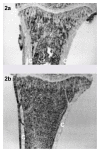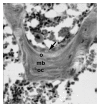Alcohol's harmful effects on bone
- PMID: 15706795
- PMCID: PMC6761900
Alcohol's harmful effects on bone
Abstract
Long-term alcohol consumption can interfere with bone growth and replacement of bone tissue (i.e., remodeling), resulting in decreased bone density and increased risk of fracture. These effects may be exerted directly or indirectly through the many cell types, hormones, and growth factors that regulate bone metabolism. Alcohol consumption during adolescence reduces peak bone mass and can result in relatively weak adult bones that are more susceptible to fracture. In adults, alcohol consumption can disrupt the ongoing balance between the erosion and the remodeling of bone tissue, contributing to alcoholic bone disease. This imbalance results in part from alcohol-induced inhibition of osteoblasts, specialized cells that deposit new bone. Some evidence suggests that moderate drinking may decrease the risk of fracture in postmenopausal women.
Figures




Similar articles
-
Alcohol and bone: review of dose effects and mechanisms.Osteoporos Int. 2012 Jan;23(1):1-16. doi: 10.1007/s00198-011-1787-7. Epub 2011 Sep 17. Osteoporos Int. 2012. PMID: 21927919 Review.
-
Alcohol-induced bone disease: impact of ethanol on osteoblast proliferation.Alcohol Clin Exp Res. 1997 May;21(3):392-9. doi: 10.1111/j.1530-0277.1997.tb03781.x. Alcohol Clin Exp Res. 1997. PMID: 9161596 Review.
-
[The potential effects of alcohol on bone mass in menopausal women: review of the literature].Sante Publique. 1999 Mar;11(1):7-16. Sante Publique. 1999. PMID: 10361833 Review. French.
-
Alcohol's impact on kidney function.Alcohol Health Res World. 1997;21(1):84-92. Alcohol Health Res World. 1997. PMID: 15706766 Free PMC article. Review.
-
Effect of duration of alcohol consumption on calcium and bone metabolism during pregnancy in the rat.Alcohol Clin Exp Res. 2003 Sep;27(9):1507-19. doi: 10.1097/01.ALC.0000086063.71754.C1. Alcohol Clin Exp Res. 2003. PMID: 14506413
Cited by
-
Osteonecrosis Related to Steroid and Alcohol Use-An Update on Pathogenesis.Healthcare (Basel). 2023 Jun 26;11(13):1846. doi: 10.3390/healthcare11131846. Healthcare (Basel). 2023. PMID: 37444680 Free PMC article. Review.
-
Circadian Mechanisms in Alcohol Use Disorder and Tissue Injury.Alcohol Clin Exp Res. 2018 Apr;42(4):668-677. doi: 10.1111/acer.13612. Epub 2018 Mar 8. Alcohol Clin Exp Res. 2018. PMID: 29450896 Free PMC article. Review.
-
Vitamin E improved bone strength and bone minerals in male rats given alcohol.Iran J Basic Med Sci. 2017 Dec;20(12):1360-1367. doi: 10.22038/IJBMS.2017.9610. Iran J Basic Med Sci. 2017. PMID: 29238472 Free PMC article.
-
Association between alcohol consumption and Korean young women's bone health: a cross sectional study from the 2008 to 2011 Korea National Health and Nutrition Examination Survey.BMJ Open. 2015 Oct 13;5(10):e007914. doi: 10.1136/bmjopen-2015-007914. BMJ Open. 2015. PMID: 26463219 Free PMC article.
-
Caring for the Bone Health Among Liver Transplant Recipients.J Clin Exp Hepatol. 2023 Nov-Dec;13(6):1130-1139. doi: 10.1016/j.jceh.2023.05.003. Epub 2023 May 12. J Clin Exp Hepatol. 2023. PMID: 37975037 Free PMC article. Review.
References
-
- Arria AM, Tarter RE, Van Thiel DH. The effects of alcohol abuse on the health of adolescents. Alcohol Abuse and Adolescent Health. 1991;15:52–57.
-
- Balabanova VS, Nowak R, Reinhardt G. Die Rolle der Calcium-Homöostase-Hormone bei der Toleranzentwicklung nach Drogen-und Alkoholkonsum. Beitrage zur Gerichtliche Medezin. 1989;47:379–383. - PubMed
-
- Bikle DD. Alcohol-induced bone disease. In: Simopoulos AP, Galli C, editors. Osteoporosis: Nutritional Aspects. Basel, Switzerland: Karger; 1993. pp. 53–79. - PubMed
-
- Chappard D, Plantard B, Petitjean M, Alexandre C, Riffat G. Alcoholic cirrhosis and osteoporosis in men: A light and scanning electron microscopic study. Journal of Studies on Alcohol. 1991;52:269–274. - PubMed
-
- Chavassieux P, Serre CM, Vergnaud P, Delmas PD, Meunier PJ. In vitro evaluation of dose-effects of ethanol on human osteoblastic cells. Bone and Mineral. 1993;22:95–103. - PubMed
Publication types
MeSH terms
Substances
Grants and funding
LinkOut - more resources
Full Text Sources
Medical
